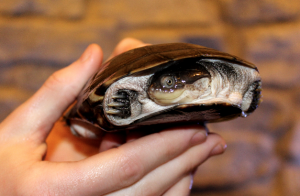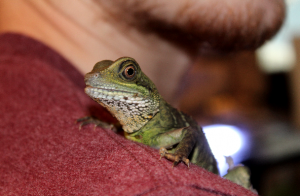Plainfield Student Runs Small Animal Rescue
Writer / Christy Heitger-Ewing
Photographer / Darren Boston
For as long as he can remember, Jack Estes has adored creatures of all shapes and sizes. Then on his 14th birthday, he got a betta fish named Apollo. He began researching how to properly care for it and learned that fish who live in small bowls die an untimely death because they’re forced to swim around in their own feces, which is toxic. Estes gave Apollo a 10-gallon tank all to himself, and a passion was born.
 “Apollo jumpstarted my love for helping abused or neglected animals,” says Estes, who went on to adopt fish, turtles, rabbits, mice, lizards, guinea pigs and hamsters. His rescue has grown to a whopping 184 animals, each of which has been given its own name. For instance, there’s Chunk and Pipsqueak, sister dwarf hamsters, a gold barb fish named Spaz and a fancy guppy named Biggie Smalls.
“Apollo jumpstarted my love for helping abused or neglected animals,” says Estes, who went on to adopt fish, turtles, rabbits, mice, lizards, guinea pigs and hamsters. His rescue has grown to a whopping 184 animals, each of which has been given its own name. For instance, there’s Chunk and Pipsqueak, sister dwarf hamsters, a gold barb fish named Spaz and a fancy guppy named Biggie Smalls.
“I give them individual names and individual care,” says Estes, who rises at 4:40 a.m. daily to begin his 2-hour morning routine. He starts by giving fresh food and water to his diurnal animals (those active during dawn and dusk). Next, he wakes his day animals, then his fish, dogs and cats. The turtles and lizards aren’t fed until afternoon.
Because Estes runs the rescue out of his bedroom, he can only take small animals. In the future, however, he hopes to become a 501c3-nonprofit organization and expand the rescue to include all creatures, including exotic ones like the Capybara, a mammal native to South America and the largest living rodent in the world, weighing more than 200 pounds.
Through the years, Estes has had to cap the number of animals he can take in when he’s felt overwhelmed by life. Besides being a pet rescue superhero, he’s also an honor student and prior to graduating from Plainfield High School in May, worked as senior editor of the school newspaper and yearbook staff. He also juggles part-time jobs.
Earlier this year, Estes sold his bed in order to make more space for cages and tanks. He now sleeps on a couch in his room.
Estes will attend IUPUI in the fall to earn a Master’s in biology before transferring to Purdue to pursue a degree in veterinary medicine. Just because he’s starting college doesn’t mean he’s abandoning his pet rescue though. He and some friends who also have rescued pets plan to rent an old house in downtown Indy and live there together with their animals. Payton has a snake, two cats and a turtle. Kitana has three geckos, a blue-tongued skink, two cats, two ferrets and a chinchilla.
Estes usually acquires animals from people who relinquish them once they’ve gotten in over their heads. For example, a classmate purchased a Chinese water dragon from a pet store, having no idea it would ultimately grow to be a foot long. After the novelty wore off, she put it in a glass tank underneath her bed, neglecting to feed or water him. When Estes rescued Goji, he was at death’s door.
“He couldn’t walk on his own,” Estes says. “His fingers and the end of his tail were bent due to a severe calcium deficiency.”
 Once Estes began feeding Goji a steady diet of live crickets doused in mealworms and topped with calcium powder, he began to thrive. Estes also rescued Teacup, a side-neck snapping turtle, from someone who had stabbed her multiple times as evidenced by the knife marks in the shell.
Once Estes began feeding Goji a steady diet of live crickets doused in mealworms and topped with calcium powder, he began to thrive. Estes also rescued Teacup, a side-neck snapping turtle, from someone who had stabbed her multiple times as evidenced by the knife marks in the shell.
Estes says there’s no excuse for owners to be naïve about proper animal care, especially in the age of the Internet.
“People can Google how to care for a pet,” says Estes, who like his hero the late Steve Irwin, equally respects all forms of life. He notes that the trouble with our culture is that pets are often viewed as disposable. “If my fish dies, oh, well, I’ll flush it and get another”. That line of thinking sickens Estes.
“If you neglect giving an animal proper care, you’re robbing a living thing of a great life,” says Estes, whose mission it is to teach the public to research an animal before bringing it home. Too often people acquire a pet on a whim simply because it’s cute. For instance, chinchillas are adorable but extremely difficult to keep healthy because they’re from the mountain regions of South America and are extremely sensitive to changes in temperature and humidity. As a result, they have a weak immune system.
“When you bring a chinchilla to Indiana and sit it in a cage, it’ll get sick and die fast,” Estes says. “The cage has to be cool enough and dry enough. It’s not a typical  rodent.”
rodent.”
Estes has taken several online pre-vet courses and in-person workshops at Purdue’s downtown location so that he can learn as much as possible about rehabilitation and medication. As a result, he’s able to clean and sanitize most wounds. He’s also learned how to alleviate many diseases, such as swim bladder disease, a common ailment in aquarium fish. The DIY aspect of his pet rescue is partly how he keeps the costs down since he funds the entire pet rescue operation himself. He estimates spending just over $200 per month on food and supplies.
“I’ve never had anyone offer a donation to the pet rescue,” Estes says. “If that ever happened, I’d probably break into tears and thank them a million times over.”
Estes recalls the heartbreaking time he lost a bunch of fish from a bacteria that infected the tank. It was his first community set-up, and he filled a tank with 20 guppies and mollies, including cherry barbs, catfish and other species.
 “They were loving life and then one day I noticed a white dot on one of their fins,” Estes says. It was a parasite that attaches to fish, destroys their scales and kills them. As soon as he spotted it, Estes quarantined the bettas. He even feigned sickness himself so he could stay home from school to try and save his fish. Sadly, he couldn’t isolate the disease and one by one, they started to die.
“They were loving life and then one day I noticed a white dot on one of their fins,” Estes says. It was a parasite that attaches to fish, destroys their scales and kills them. As soon as he spotted it, Estes quarantined the bettas. He even feigned sickness himself so he could stay home from school to try and save his fish. Sadly, he couldn’t isolate the disease and one by one, they started to die.
“Every time I lost another one, my heart broke into pieces,” Estes says. A guppy named Big Momma was pregnant during the outbreak and was so sick that she was too weak to give birth on her own. Estes pulled her from the tank and using a tiny pair of rubber tongs he squeezed lightly on her body to push out the babies. All were stillborn but one, whom Estes named Tupac Junior, after his father. Big Momma died right after giving birth.
Ultimately, only three fish survived. The experience only served to fortify Estes’ resolve to save the animal planet. Each morning, he gently talks to his creatures, greeting them and asking how they’re doing.
“These animals have seen the hateful nature of humans so I imagine they appreciate hearing someone with a soft voice who wants to love them,” Estes says. He’s  witnessed, firsthand, how such TLC can change an animal. Take Teacup, the turtle who suffered the awful stab wounds. She was scared to death when she first entered Estes’ home. Now, however, she waves her little flippers to say hello.
witnessed, firsthand, how such TLC can change an animal. Take Teacup, the turtle who suffered the awful stab wounds. She was scared to death when she first entered Estes’ home. Now, however, she waves her little flippers to say hello.
“I’ll be happy when I see a generation of kids start appreciating pets and animals,” Estes says. “That’s my dream.”
Until then, Estes continues to heal the world, one fish at a time.
If you’d like to talk to Jack about surrendering an animal or if you’re interested in making a donation to his Small Animal Rescue, contact him at avantichamp@gmail.com.







Comments 1
Thank you Jack for sharing your story and for your love of all creatures! It's nice to see a young man such as yourself doing wonderful thinks for animals!